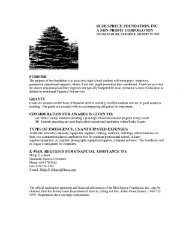EXPLORING PSYCHOLOGY (7th Edition) David Myers ...
EXPLORING PSYCHOLOGY (7th Edition) David Myers ...
EXPLORING PSYCHOLOGY (7th Edition) David Myers ...
You also want an ePaper? Increase the reach of your titles
YUMPU automatically turns print PDFs into web optimized ePapers that Google loves.
<strong>EXPLORING</strong><strong>PSYCHOLOGY</strong>(<strong>7th</strong> <strong>Edition</strong>)<strong>David</strong> <strong>Myers</strong>Psychological DisordersChapter 13Psychological Disorders—What type of disorder is this?I felt the need to clean my room … would spend four to five hours at it … At the time Iloved doing it. Then I didn't want to do it any more, but I couldn’t stop … The clotheshung … two fingers apart …I touched my bedroom wall before leaving the house … Ihad constant anxiety … I thought I might be nuts.What is abnormal?•What behaviors should cause someone to be labeled with a disorder?•Distress or Disability•Maladaptiveness•Irrationality•Unpredictability•Unconventionality (deviant) and Statistical Rarity•Observer Discomfort•Violation of Moral and Ideal StandardsHow did they treat psychological disorders in ancient times?The Medical ModelPhilippe Pinel (1745-1826) from France, insisted that madness was not due to demonicpossession, but an ailment of the mind.Medical Model1. Etiology: Cause and development of the disorder.2. Diagnosis: Identifying (symptoms) and distinguishing one disease from another.3. Treatment: Treating a disorder in a psychiatric hospital.4. Prognosis: Forecast about the disorder.Classifying Psychological DisordersLabeling Psychological Disorders•Why do they label people with psychological disorders? And Is that good or bad?
Labeling Psychological Disorders•Critics of the DSM-IV argue that labels may stigmatize individuals•Labels may be helpful for healthcare professionals when communicating with oneanother and establishing therapy.Labeling Psychological Disorders• “Insanity” labels raise moral and ethical questions about how society should treatpeople who have disorders and have committed crimes.Anxiety Disorders:Generalized Anxiety DisorderPanic DisorderAnxiety and PanicObsessive-compulsive disorderPost-traumatic stress disorderGeneralized Anxiety Disorder1. Persistent and uncontrollable tenseness and apprehension.2. Autonomic arousal.3. Inability to identify or avoid the cause of certain feelings.Panic DisorderMinutes-long episodes of intense dread which may include feelings of terror, chest pains,choking, or other frightening sensations.Anxiety is a component of both disorders. It occurs more in the panic disorder, makingpeople avoid situations that cause it.PhobiasMarked by a persistent and irrational fear of an object or situation that disrupts behavior.Brain ImagingA PET scan of the brain of a person with Obsessive-Compulsive Disorder (OCD). Highmetabolic activity (red) in the frontal lobe areas are involved with directing attention.Obsessive-Compulsive Disorder (OCD):Persistence of unwanted thoughts (obsessions) and urges to engage in senseless rituals(compulsions) that cause distress.Post-Traumatic Stress DisorderFour or more weeks of anxiety symptoms following a traumatic incident.Explaining Anxiety DisordersFreud suggested that we repress our painful and intolerable ideas, feelings, and thoughts,resulting in anxiety.
The Learning PerspectiveLearning theorists suggest that fear conditioning leads to anxiety. This anxiety thenbecomes associated with other objects or events (stimulus generalization) and isreinforced.The Biological PerspectiveNatural Selection has led our ancestors to learn to fear snakes, spiders, and other animals.Therefore, fear preserves the species.Dissociative DisordersConscious awareness becomes separated (dissociated) from previous memories, thoughts,and feelings.1. Having a sense of being unreal2. Being separated from the body3. Watching yourself as if in a movieDissociative Identity Disorder (DID)A disorder in which a person exhibits two or more distinct and alternating personalities,formerly called multiple personality disorder.Cases of DID: “Sybil,” “Three Faces of Eve”DID Critics: How real is this disorder?Critics argue that the diagnosis of DID increased in the late 20 th century. DID has notbeen found in other countries.Personality DisordersPersonality disorders are characterized by inflexible and enduring behavior patterns thatimpair social functioning. They are usually without anxiety, depression, or delusions.Antisocial Personality DisorderA disorder in which the person (usually men) exhibits a lack of conscience forwrongdoing, even toward friends and family members. Formerly, this person was called asociopath or psychopath.Understanding Antisocial Personality DisorderPET scans of 41 murderers revealed reduced activity in the frontal lobes. In a follow-upstudy, repeat offenders had 11% less frontal lobe activity (Raine et al., 1999; 2000).Mood DisordersEmotional extremes of mood disorders come in two principal forms.1. Major depressive disorder2. Bipolar disorderMajor Depressive DisorderDepression is the “common cold” of psychological disorders. In a year, 5.8% of men and9.5% of women report depression worldwide (WHO, 2002).
Major depressive disorder occurs when signs of depression last two weeks or more andare not caused by drugs or medical conditions.Bipolar DisorderFormerly called manic-depressive disorder. An alternation between depression and maniasignals bipolar disorder.SuicideThe most severe form of behavioral response to depression is suicide. Each year some 1million people commit suicide worldwideBiological PerspectiveGenetic Influences: Mood disorders run in families. The rate of depression is higher inidentical (50%) than fraternal twins (20%).The Depressed BrainPET scans show that brain energy consumption rises and falls with manic and depressiveepisodes.SchizophreniaThe literal translation is “split mind” which refers to a split from reality. A group ofsevere disorders characterized by the following:1. Disorganized and delusional thinking.2. Disturbed perceptions.3. Inappropriate emotions and actions.Symptoms of SchizophreniaPositive symptoms: the presence of inappropriate behaviors (hallucinations, disorganizedor delusional talking)Negative symptoms: the absence of appropriate behaviors (expressionless faces, rigidbodies)Disorganized & Delusional Thinkingdelusions (“I’m Mary Poppins”).Other forms of delusions include, delusions of persecution (“someone is following me”)or grandeur (“I am a king”).Disturbed PerceptionsA schizophrenic person may perceive things that are not there (hallucinations).Frequently such hallucinations are auditory and lesser visual, somatosensory, olfactory,or gustatory.Inappropriate Emotions & ActionsA schizophrenic person may laugh at the news of someone dying or show no emotion atall (flat affect).
Patients with schizophrenia may continually rub an arm, rock a chair, or remainmotionless for hours (catatonia).Understanding SchizophreniaSchizophrenia is a disease of the brain exhibited by the symptoms of the mind.Brain AbnormalitiesDopamine Overactivity: Researchers found that schizophrenic patients express higherlevels of dopamine D4 receptors in the brain.Abnormal Brain MorphologySchizophrenia patients may exhibit morphological changes in the brain like enlargementof fluid-filled ventricles.Viral InfectionSchizophrenia has also been observed in individuals who contracted a viral infection (flu)during the middle of their fetal development.Genetic FactorsThe prevalence of schizophrenia in identical twins as seen in different countries.Psychological FactorsThe following shows the prevalence of schizophrenia in identical twins as seen indifferent countries.Rates of Psychological Disorders
















